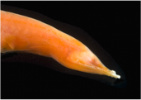Marine researchers have discovered the Atlantic longarm octopus mimicking not only the color and appearance of the peacock flounder, but also its unique style of swimming in order to convince predators it’s something it’s not.
By comparing film footage and photographs from the five Caribbean locations, the researchers saw that the Atlantic longarm octopus (Macrotritopus defilippi) was deftly mimicking a peacock flounders’ ( Bothus lunatus ) behavior and coloration. Octopus, a member of the cephalopod family, have evolved a unique skin system that can change color at will, however the researchers say the Atlantic longarm octopus is particularly skilled.
 Atlantic longarm octopus in the aquarium; note the long thin arms characteristic of the species. Photo by John Forsythe. |
“We were equally impressed with the remarkable camouflage of this small octopus species even when it was stationary yet entirely exposed on top of the open sand,” lead author Roger Hanlon, Marine Biology Laboratory Senior Scientist, said in a press release. “The apparent match in pattern, color, brightness, and even 3-dimensional skin texture was noteworthy even when compared to other changeable cephalopods. They also demonstrated an unusual form of disruptive camouflage.”
But the octopus changed its behavioral patterns as well as its appearance. Mimicking the peacock flounder’s characteristic swimming style, the octopus hugged its body to the seafloor and let its arms hang loosely behind as though it were the flounder’s tail. The octopus also swam in the odd start-and-stop pattern of a flounder.
 Atlantic longarm octopus swimming forward and mimicking the shape, speed, and behavior of flounder swimming. Photo by R. Hanlon. |
Researchers speculate that the octopus mimics the flounder to protect itself from predation. Potential predators would likely choose a soft octopus to attack over a firm flat flounder; however more research is need to confirm this.
While Hanlon has uncovered similar behavior of flounder-mimicry in two other octopus species in Indonesia, this is the first time the researchers observed the behavior in the Atlantic.
The study was published in the February issue of The Biological Bulletin.
Atlantic longarm octopus, Macrotritopus defilippi imitating a flounder.
Related articles
Video: Octopus joins elite club of tool-users with coconut sanctuary
(12/15/2009) Highly-intelligent, octopuses have been observed opening containers, navigating mazes, and escaping from cages. Now, researchers have discovered a new intellectual feat for the octopus: tool use. Once the province of humans only, over the last 50 years researchers have discovered that many species—including primates, apes, and birds—employ tools, but the octopus is the first invertebrate.
Expedition to save world’s rarest cetacean threatened by lack of funding
(02/11/2010) Little known beyond the waters of the Gulf of California, the world’s smallest cetacean (a group including whales, dolphins, and porpoises) is hanging on by a thread. The vaquita—which in Spanish means ‘little cow’—has recently gained the dubious distinction of not only being the world’s smallest cetacean, but the also the world’s rarest. In 2006 it was announced that the Yangtze river dolphin, or baiji, was likely extinct, and conservationists fear the Critically Endangered ‘little cow’ is next. An expedition for this year is set to identify vaquita individuals, but even this is threatened by lack of funding.
Videos and Photos: over 17,000 species discovered in waters beyond the sun’s reach

(11/23/2009) Deep, deep below the ocean’s surface, in a world of ever-present darkness, one would expect few, if any, species would thrive. However, recent expeditions by the Census of Marine Life (CoML) have found an incredible array of strange, diverse, and amazing creatures. To date a total of 17,650 species are now known to live in frigid, nearly lightless waters beyond the photic zone—where enough light occurs for photosynthesis—approximately 200 meters deep. Nearly 6,000 of these occur in even harsher ecosystems, below depths of 1,000 meters or 0.62 miles down.
New species of ghostshark discovered off California’s coast
(09/22/2009) The discovery of Eastern Pacific black ghostshark Hydrolagus melanophasma is notable for a number of reasons. It is the first new species of cartilaginous fish—i.e fish whose skeletons are made entirely of cartilage, such as sharks, rays, and skate—to be described in California water since 1947. It is also a representative of an ancient and little-known group of fish.
Whale skeleton reveals species unknown to science
(09/22/2009) The importance of a whale to the oceanic ecosystem does not end with its life. After dying, a whale’s body sinks to the bottom of the ocean and becomes food for many species, some of whom specialize on feeding on these corpses.















